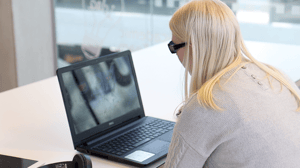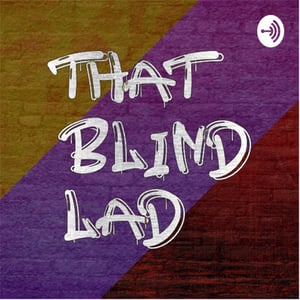We're delighted to welcome Jamie McAllister - better known as podcaster 'That Blind Lad' - to the Dolphin blog. Jamie is a 21 year old student, Twitter regular and host of his own podcast ‘That Blind Lad'. On the podcast, Jamie chats with prominent disabled people about their achievements, life journeys and shared experiences.
In this blog we learn what assistive technology means to Jamie, and hear his suggestions as to how the people involved in creating digital content can easily improve its accessibility for use with screen readers.
My name is Jamie McAllister, I’m 21 and registered blind. The condition I have is known as Stickler Syndrome, which affects my vision, hearing and muscle joints. I’ve only been completely blind for around three years, though I’ve had issues with my eyesight ever since I can remember. I’ve learnt not to let it stop me from doing the things I love.
As a 21-year old lad, I’m into all the things you might expect: football, nights out and trying new things, no matter how scary or daunting they may seem. Football was - and still is - my beacon of light, it really pulled me through the literal dark times when I lost my sight. Football is one of the main reasons behind the confidence I have now and the positive attitude I possess. A nine-hour round trip to Sunderland to see your team draw has its benefits, believe it or not!
I also host my own podcast – That Blind Lad’s Podcast – where I interview people from the disabled community about their journeys, experiences, achievements and much more. It has provided me with opportunities to talk to people such as multi-medal winning Paralympian Tanni Grey-Thompson, and disability and climate activist Pauline Castres.
The podcast has enabled me to learn more about the lives of a multitude of disabled people and it’s given me more insight into the challenges that each person faces day in-day out. At the same time it’s highlighted the amazing work these people do so that they - and others like them - can have equal opportunities to the rest of the world.
Especially when the very thing we are fighting for shouldn’t be an issue in the first place!You should never underestimate the power of a group of people who are all fighting for the same thing.
What accessible technology means to me
In a nutshell, accessible technology equals independence. Maybe not complete independence, but it puts me on track to being so.
As a 21-year old, my phone plays such an important part in my life. Whether I’m using AI technology to speak to a device - asking it to play music or tell me the time - or using screen reader software to access social media.
You often don’t realise how much of the accessible tech now available in the mainstream all started with the intention of assisting disabled people. I would go as far as saying the screen reader on my phone was a lifesaver for me, especially when I lost my sight and thought I could never use my phone to its full capability again.
Assistive technology means I can interact with people all over the world.
What accessible technology allows me to do
Discovering and then using accessible technology has enabled me to do so many things and has given me so many incredible opportunities. The main source of all this for me personally is Twitter.
Yes, you see negative stories about social media on a daily basis and I’m not pretending it’s a lovely place 24/7, but the majority of people I’ve met through Twitter and the opportunities I’ve been able to take because of it have really changed my life. I wouldn’t be here writing this very blog if it wasn’t for that platform, and the reach it’s given me. Twitter has also been a great tool for spreading the word about my podcast and getting guests for me to interview. Eliminate social media and that process would be much more difficult.
Accessible technology – screen readers in particular - allow me to complete small tasks such as shopping online or browsing the web. These are things I didn’t think were possible when I lost my sight completely, so tech helps with the practical side of being independent.
I remember when I had a bit of vision left, but not enough to use my phone entirely, I would have to go to a family member and ask them to complete a task on my phone, or have them look at something in particular. I used to hate it. Relying on someone else’s availability in order to complete a small task online was demoralising to say the least. That’s not to say I don’t have to do that whatsoever anymore, as there are still websites and apps that are not very accessible or screen reader friendly. Now I know this is down to the people behind these sites and apps, which is out of my control and something I can’t manage.
Easy ways to make social posts, websites and apps accessible
Accessible technology is amazing but it doesn’t solve every issue I have with accessing information online. There are areas where the assistive technology itself and developers of websites and apps need to come together, communicate and provide the right information in the right places. Doing this would help us move forward to reach our goal of every website and app being accessible.
One of the most important things to me is image description. In the tech world it’s known as Alt Text. I am a big advocate of using this on social media especially, but it can be also used on websites, electronic documents and anywhere a digital image is displayed. Put simply, it’s a label describing the image that’s added into the code (much easier than it sounds). A screen reader will pick this up and read it aloud, to describe the image when the reader is not able to see it.
The addition of Alt Text is usually down to developers adding it when their website is either being created or modified, or the person posting on social media adding it when they post. It’s so simple, but so effective for a blind person like myself. It allows me to understand a social media post better and adds a bit of life to an article I’m reading online.
Without getting too technical, other things that could be improved are the simple labelling of buttons or links on websites and apps. Too many times I’ve had to delete an app or avoid using a website because my screen reader is unable to pick up any useful instructions. The website might just repeat the words on each button or link - ‘click here, click here, click here’ - which leaves me guessing what each link does and that isn’t fun at all! Once again, this is easy for developers and website content writers to improve.
I recommend accessibility should be one of the first things website and platform creators consider when developing their site or app. It must be easier to build in from the start than retrofit afterwards.
Founders of websites and apps will gain more traction because of accessibility, while people like me will be able to access information properly and use the app or website well. We won’t feel excluded or left out from whatever the new trend or product is.
If these things are worked on and implemented then no one loses out, everyone’s a winner!The world is a better place when we can all access the same media and content, without barriers or challenges.
That Blind Lad’s Podcast
Hosted by Jamie McAllister, That Blind Lad’s Podcast focuses on disability and chronic illness.
Jamie interviews and chats with prominent names in the disabled community about their experiences and achievements, with a blend of seriousness and humour throughout.
About Stickler Syndrome
According to Stickler Syndrome UK, Stickler Syndrome is a group of genetically inherited conditions that affects the collagen - connective tissue - in a person’s body.
Also known as Hereditary Progressive Arthro-ophthalmopathy, the symptoms and severity of Stickler syndrome vary from patient to patient. It may affect eyesight, bones and joints, facial features and palate, it can also cause hearing loss and chronic fatigue.
Further information on Stickler Syndrome >
Other blogs you might enjoy
![]()
6 Ways to make digital content accessible

Funding for students with visual impairments
Dolphin products for students
Dolphin offers a range of software that helps make learning material accessible to more students.
With Dolphin software, schools, colleges and universities can support students who are blind, have low vision or partial sight.
Additionally, Dolphin products support a range of neurodiverse learners, including autistic and dyslexic students.




Let Us Know What You Thought about this Post.
Write your comment below.